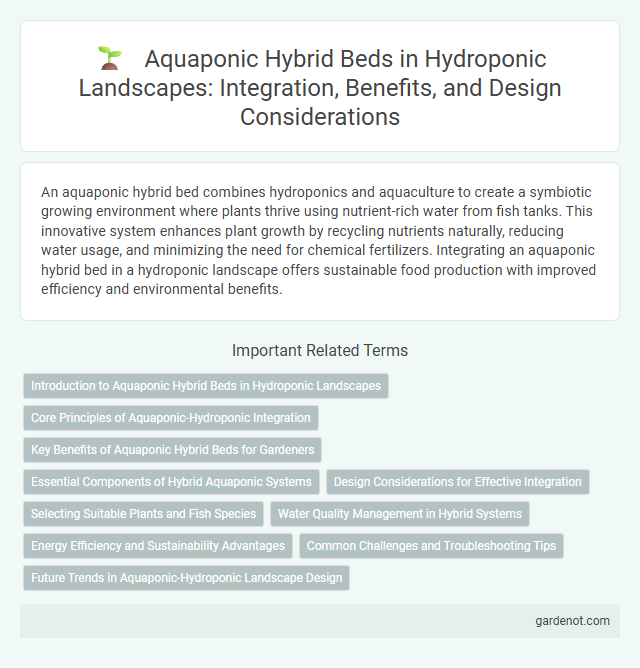An aquaponic hybrid bed combines hydroponics and aquaculture to create a symbiotic growing environment where plants thrive using nutrient-rich water from fish tanks. This innovative system enhances plant growth by recycling nutrients naturally, reducing water usage, and minimizing the need for chemical fertilizers. Integrating an aquaponic hybrid bed in a hydroponic landscape offers sustainable food production with improved efficiency and environmental benefits.
Introduction to Aquaponic Hybrid Beds in Hydroponic Landscapes
Aquaponic hybrid beds combine aquaculture and hydroponics to create a sustainable ecosystem where fish and plants coexist, optimizing resource use in hydroponic landscapes. These beds utilize nutrient-rich water from fish tanks to nourish plants, while plants naturally filter and purify the water, enhancing growth and reducing waste. Integrating aquaponic hybrid beds in hydroponic systems improves water efficiency, reduces chemical fertilizers, and supports organic crop production.
Core Principles of Aquaponic-Hydroponic Integration
Aquaponic hybrid beds combine hydroponic nutrient solutions with aquaculture systems, optimizing nutrient recycling through fish waste conversion into bioavailable forms for plants. Core principles include maintaining balanced water quality parameters such as pH, dissolved oxygen, and nutrient concentration to support both fish and plant health. Efficient integration hinges on microbial biofiltration processes that convert toxic ammonia from fish into nitrates, ensuring sustainable nutrient cycling and maximizing crop yield.
Key Benefits of Aquaponic Hybrid Beds for Gardeners
Aquaponic hybrid beds maximize water efficiency by combining aquaculture with hydroponic plant cultivation, enabling nutrient-rich water recycling that reduces waste and supports sustainable gardening. Gardeners benefit from faster plant growth rates due to continuous nutrient availability from fish waste, leading to higher yields without chemical fertilizers. These systems promote healthy ecosystems, reducing pest problems and enhancing biodiversity within the garden environment.
Essential Components of Hybrid Aquaponic Systems
Essential components of hybrid aquaponic systems include a grow bed, fish tank, and biofilter, which work together to create a symbiotic environment for plants and aquatic life. The grow bed supports hydroponic plant roots, while the fish tank provides nutrient-rich water through fish waste, and the biofilter converts ammonia into nitrates for optimal plant uptake. Proper aeration, water circulation pumps, and monitoring systems ensure balanced oxygen levels and nutrient distribution, promoting efficient growth in aquaponic hybrid beds.
Design Considerations for Effective Integration
Design considerations for an aquaponic hybrid bed emphasize balancing water flow rates and nutrient distribution to optimize both plant growth and fish health. Material selection should ensure durability and water safety, while system layout maximizes space efficiency and facilitates easy maintenance. Integrating biofiltration and monitoring systems supports effective waste conversion and maintains optimal environmental conditions.
Selecting Suitable Plants and Fish Species
Selecting suitable plants for aquaponic hybrid beds involves choosing species that thrive in nutrient-rich, water-based environments such as leafy greens, herbs, and certain fruiting vegetables. Popular fish species include tilapia, catfish, and trout, known for their adaptability to controlled aquatic systems and efficient nutrient conversion. Balancing plant and fish choices optimizes nutrient cycling, system stability, and overall yield in hydroponic landscape setups.
Water Quality Management in Hybrid Systems
Effective water quality management in aquaponic hybrid beds is critical to maintaining optimal nutrient balance and fish health. Monitoring key parameters such as pH, dissolved oxygen, ammonia, nitrites, and nitrates ensures a stable environment for both aquatic organisms and plants. Implementing biofiltration and regular water testing minimizes toxic buildup and promotes efficient nutrient cycling in hydroponic landscape systems.
Energy Efficiency and Sustainability Advantages
Aquaponic hybrid beds integrate fish farming with hydroponic plant cultivation, significantly reducing water usage by recycling nutrient-rich water within a closed-loop system. These systems capitalize on natural biological processes to minimize energy consumption for nutrient supply and filtration compared to traditional soil-based agriculture. The symbiotic relationship between aquatic animals and plants enhances sustainability by lowering waste output while producing both protein and fresh vegetables efficiently.
Common Challenges and Troubleshooting Tips
Aquaponic hybrid beds often face challenges such as nutrient imbalances, system clogging, and maintaining optimal pH levels between 6.8 and 7.2 to support both fish and plants. Regular monitoring of water quality parameters including ammonia, nitrites, and nitrates, along with routine cleaning of mechanical filters, helps prevent system blockages and fish stress. Adjusting feeding rates and integrating biofilters ensures stable microbial activity, promoting healthy plant growth and efficient nutrient cycling.
Future Trends in Aquaponic-Hydroponic Landscape Design
Aquaponic hybrid beds integrate aquaculture and hydroponics to create sustainable, symbiotic ecosystems that optimize water and nutrient use in landscape design. Future trends emphasize automated nutrient monitoring and AI-driven environmental controls to maximize crop yield and ecological balance. Innovations in vertical farming and modular system scalability are set to revolutionize urban green spaces by enhancing food production and biodiversity.
Aquaponic hybrid bed Infographic

 gardenot.com
gardenot.com